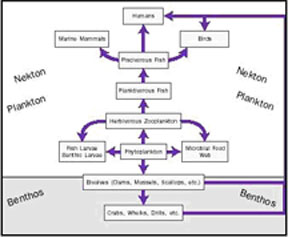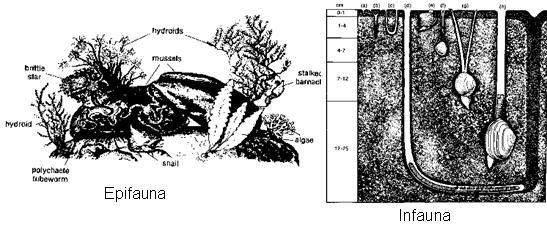Difference between revisions of "Functional diversity in marine ecosystems"
| Line 47: | Line 47: | ||
* A6 Deep-sea bed [[photo A6]] | * A6 Deep-sea bed [[photo A6]] | ||
| − | * A7 Pelagic water column [[ | + | * A7 Pelagic water column [[photo A7]] |
* A8 Ice-associated marine habitats [[photo A8]] | * A8 Ice-associated marine habitats [[photo A8]] | ||
Revision as of 10:50, 22 August 2007
Functional diversity refers to the variety of biological processes, functions or characteristics of a particular ecosystem.
[1]Functional diversity reflects the biological complexity of an ecosystem. Some scientists argue that examining functional diversity may in fact be the most meaningful way of assessing biodiversity while avoiding the difficult and usually impossible task of cataloging all species in marine ecosystems. By focusing on processes, it may be easier to determine how an ecosystem can most effectively be protected. Protecting biological functions will protect many of the species that perform them. However, the exact function of most of the species is hardly known to date.
[2]There are several ways in which ecological classifications group organisms according to common functions: classification according to their habitat, to their position in the food web or to their functional feeding mechanism.
Contents
Classification by ‘habitat’
Aquatic organisms can be divided into four major groups: pelagic, benthic, neuston and fringing, according to the water body which they inhabit.[2]
PELAGIC ORGANISMS
Pelagic organisms are those that live in ocean water (not associated with the bottom) thus in the water column and can be divided in plankton and nekton. Plankton are organisms that are suspended, (they float or are weakly self-propelled) in the water and drift with it as it moves. Plankton is either passive and includes algae, bacteria and variety of animals. Plankton is usually subdivided in phytoplankton (photosynthethic organisms like algae) and zooplankton (animals), what refers to their ecological function. Plankton can also be subdivided in holoplankton and meroplankton. Holoplankton are permanent members, represented by many taxa in the sea. Meroplankton are temporary members, spending only a part of their life cycle in the plankton. They include larvae of anemones, barnacles, crabs and even fish, which later in life will join the nekton or the benthos. Meroplankton are very much a feature of the sea, particularly coastal waters, as the often sedentary adult forms of coastal species use their planktonic stage for dispersal. Nekton are organisms swimming actively in the water, it includes a variety of animals, mostly fish.
BENTHIC ORGANISMS.
Benthos comprises organisms on the bed of the water body. Animals attached to or living on the bottom are referred to as epifauna, while those which burrow into soft sediments or live in spaces between sediment particles are described as infauna.
Attached multicellular plants and algae are referred to as macrophytes, while single-celled or filamentous algae are called as periphyton or microphytobenthos. Epiphytic algae are those which grow on macrophytes. Benthic consumers can be divided by size into macrofauna (>500 μm), meiofauna (10-500 μm) and micro-organisms (<10 μm).
NEUSTON
Neuston are those organisms associated with the water surface, where they are supported by surface tension. Most neuston require very still water surface and is therefore very restricted in the sea.
FRINGING COMMUNITIES
Fringing communities are floral communities that occur where the water is shallow enough for plentiful light to reach the bottom, allowing the growth of attached photosynthesisers, which may be entirely submerged or emergent into the air. Marine communities are composed mostly out of algal seaweeds. Wetlands are composed of this type of vegetation.
There are a lot of other habitat classifications, for example the EUNIS Habitat types classification.[3]. This is a comprehensive pan-European system to facilitate the harmonized description and collection of data across Europe through the use of criteria for habitat identification; it covers all types of habitats from natural to artificial, from terrestrial to freshwater and marine.
An example of the EUNIS habitat classification: marine habitats at level 1 is the following:
- A2 Littoral sediment photo A2
- A3 Infralittoral rock and other hard substrata photo A3
- A4 Circalittoral rock and other hard substrata photo A4
- A5 Sublittoral sediment photo A5
- A6 Deep-sea bed photo A6
- A7 Pelagic water column photo A7
- A8 Ice-associated marine habitats photo A8
Classification by position in the food web
[4]It is very difficult to make generalizations about the trophic relationships in coastal marine systems, because the ecological habitats are so diverse. A simplified description of a food web: the phytoplankton are the primary producers and are eaten by the zooplankton (smallest floating animals). The zooplankton are eaten by small fish (sardines, herring) and small fish are eaten by larger fish. At the top of the marine food web are the large predators (tuna, seals, sea-birds and some species of whales).
Phytoplankton, small zooplankton and large zooplankton, larger animals and top predators all interact in a marine food web. Each species eats and is eaten by several other species at different trophic levels.
The interactions in a food web are far more complex than the interactions in a food chain. Furthermore, the branching structure of food webs leads to fewer top predators compared with the numbers of top predators in a food chain.
MICROBIAL LOOP
[6]In the microbial loop, bacteria consume Dissolved Organic Material (DOM) that cannot be directly ingested by larger organisms. DOM includes liquid wastes of zooplankton and cytoplasm that leaks out of phytoplankton cells. Bacteria are eaten by microflagellates. Ciliates, which are small enough to eat microflagellates, are eaten by zooplankton. Micro-flagellates and ciliates help to recycle organic matter back into the marine food web. Bacteria also help to facilitate phytoplankton growth by releasing nutrients when they absorb DOM. Viruses are the smallest and most abundant organisms in the sea, viral activity produces DOM, thus helping to drive energy cycles for ocean life. The main difference of the microbial loop between estuarine and coastal waters is that coastal waters tend to have lower population densities of bacteria and of the organism that prey on them.

Classification by functional feeding mechanism
COASTAL BENTHOS[2]
There is a classification with several groups for marine and coastal systems:
- grazer-scrapers feed upon attached algae
- scavengers eat coarse particulate organic matter (detritus retained by a 1 mm sieve)
- collectors eat fine particulate organic matter (detritus passing through a 1 mm sieve but retained by 0.45 mm sieve)
- suspension or filter feeders remove particles from the watercolumn
- deposit feeders pick particles from the ocean bed
- predators consume other living animals
- parasites derive their food from a living organism of another species (host), they usually live in or on the body of the host.
In practice this distinction is very imprecise but useful as long as it is understood that they should not be too rigidly applied. The shelf bottom is occupied by diverse groups of benthic organisms that vary with changes in the bathymetry and sediment cover of the sea bed. For example gravel and coarse sand bottoms are mostly populated by filter feeders and fine sand bottoms are predominantly composed of deposit feeders. Muddy substrates are almost exclusively inhabited by deposit and detritus feeders.
COASTAL PELAGIC COMMUNITIES[2]
In pelagic communities the classification based on feeding mechanism is less successful because consumers are opportunistic and will eat anything that is the correct size for their mouthparts to deal with.
Nekton are almost exclusively predators. The smaller species like the zooplankton are both predators and grazers. Plankton are therefore also classified by size, although there is again an overlap as many species will change to a larger size class as they grow older.
In an estuary there is a large amount of detritus. Detritus may be consumed directly by deposit feeders or in suspension by various benthic suspension feeders Where the bottom is rocky, benthic communities are dominated by sessile filter feeders such as bivalves, sponges, barnacles, and bryozoans. Mud and sand substrates support an epifauna and an infauna of suspension and deposit feeders. The large numbers of suspension feeders and deposit feeders are consumed by a number of predators like fish and grow rapidly under the relatively low predation pressure there.
WETLANDS[2]
Fringe wetlands have a continuous or very frequent hydrological connection with the parent water body and are characterized by emergent vegetation. Flood wetlands are, for most of the time, hydrologically separated from the parent water body. Wetlands are more based on detritus than on phytoplankton. A lot of organisms in wetlands live in the substrate, to overcome the problems of oxygen shortage and toxity faced by plant roots.
References
- ↑ Thorne-Miller Boyce (1999) The living ocean: understanding and protecting marine biodiversity. United States of America 213p
- ↑ 2.0 2.1 2.2 2.3 2.4 Dobson M. and Frid C. (1998). Ecology of aquatic systems. Addison Wesley Longman Limited: Edingburgh, (England). p222
- ↑ http://eunis.eea.europa.eu/habitats.jsp
- ↑ http://oceanworld.tamu.edu
- ↑ From "Fishing down marine food webs' as an integrative concept" by Daniel Pauly (University of British Columbia, Canada), Proceedings of the EXPO'98 Conference on Ocean Food Webs and Economic Productivity, online at the Community Research and Development Information Page
- ↑ http://www.bigelow.org
- ↑ http://www.waterencyclopedia.com/images
- ↑ Pinet, P.R. (1998). Invitation to Oceanography. Jones and Bartlett Publishers. London (UK) p508
- ↑ Nybakken, J.W. (1988). Marine biology: an ecological approach. 2nd ed. Harper & Row: New York, p514
Please note that others may also have edited the contents of this article.
|
[[Category:Articles by {{{AuthorFullName}}}]]


